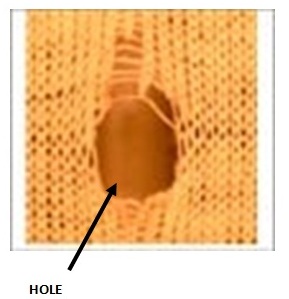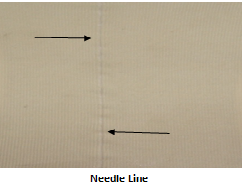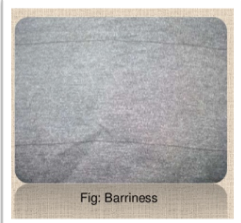INTRODUCTION
A defect of the knitted fabric is an abnormality which spoils the aesthetics i.e. the clean & uniform appearance of the fabric & effects the performance parameters, like; dimensional stability etc.
The International Standard describes defects which commonly appear during the inspection of knitted piece-goods. The purpose of this International Standard is-to define knitted-fabric defects, i.e. those characteristics that have been unintentionally introduced into the fabric. The presence of one or other of these characteristics in a fabric does not automatically imply that the fabric is sub-standard. Textile suppliers and purchasers will still have to reach agreement on whether a defect is present. If it is considered that a defect is present they will then have to agree on the limits of the defect and on any allowance to be made, bearing in mind the intended use of the fabric.
According to International Standards definition of defects, it is a fault that would reduce the expected performance of the fabric or, if it appeared in a prominent position in an article made from the fabric, would readily be seen and rejected by a prospective purchaser.
Indian Standard of knitted defect which is identical with ISO 8499:1990, classifies the defects in to 5 Sections:
Section 2: Yarn defects in a knitted fabric
Section 3: Defects in the course direction
Section 4: Defects in the length direction
Section 5: Defects due to, or apparent after, dyeing, printing or finishing
Section 6: General defects
YARN DEFECTS IN KNITTED FABRIC
Bright yarn : A yarn, in a course or wale, of higher Iustre than the adjacent yarns.
Cause : This defect is caused by irregularity in processing of the yarn, e.g. uneven distribution of delustrant, or by mixing yarns of different delustrant content, e.g. dull, semi-dull, etc.
Remedy: Specify the quality parameters of the yarns to be used for production to the yarn supplier.
Cockled yarn: Small slub-like irregularities in the yarn that are readily extensible and that cause loop distortion.
Cause: This defect is often caused by the unintentional introduction of stretch into some fibres during drafting and the subsequent relaxation of these fibres to form loops or crimps in the yarn.
Remedy: Make sure the shrinkage is in the minimal level.
Slub: In a yarn, a thickened place having tapering ends and a diameter several times that of the adjacent normal yarn.
Cause: — This defect is often caused by the presence in the yarn of fragments of undrafted roving or stubbing that have not been cleared during winding.
Remedy – Slub should be cut with the clipper in both the ends. The resultant bare patch can be corrected by combing with metallic comb.
Gout: A lumpy, asymmetrical fault in a spun yarn of a fabric.
Cause: This defect is caused by the accumulation of undraftad waste fibre into the yarn during spinning.
Remedy: The extra foreign matter can be pulled out with a plucker. Combining in both direction rectifies the resultant path.
Split yarn: A yarn which appears in the fabric as a thin yarn.
Cause: This defect is often caused by abrasion or excessive tension during winding or knitting, which breaks a part of the yarn (e.g. a filament of a continuous-filament yarn or a ply of a two-fold yarn) that is subsequently held back during knitting.
Remedy: Ensure uniform Yarn Tension on all the feeders.
 SLUB
SLUB

SPLIT YARN
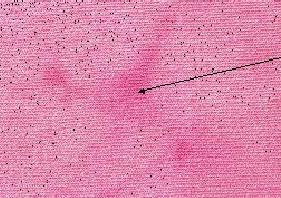
BRIGHT YARN
DEFECTS IN THE COURSE DIRECTION
Bowing: Excessive curvature of the courses in a fabric that may or may not extend over the full -width.
Cause: This defect is often caused by incorrect take-down tension during knitting or incorrect feeding during finishing
Remedy: Bowing can be corrected by reprocessing the fabric by feeding it from the opposite end and a special machine (MAHLO) is also available for correcting the bowing in the knitted fabrics.
Missing yarn: A yarn absent from a pattern.
Cause: — This defect is the result of a machine continuing to run with one feed of yarn missing.
Remedy: Yarn Threading through the right bore and CKM element checking
Thick place: A prominent band in which an increase in stitch density, compared to the rest of the fabric, is apparent.
Cause: This defect is often caused by a poor start-up of the machine, or uneven let-off or take-up.
Remedy: Make sure that the Machine is serviced properly
Thin place: A prominent band in which a decrease in stitch density, compared to the rest of the fabric, is apparent.
Cause: This defect is often caused by uneven yarn let-off or fabric take-up.
Remedy: Make sure that the Machine is serviced properly
Wrong yarn: A yarn in a weft-knitted fabric that differs from normal yarn in respect of composition, thickness, filament or colour.
Cause: This defect is caused by a lack of control of incoming material.
Remedy: Rigid control measures in the Blow Room to prevent the mixing of foreign matters in the Cotton mixing.
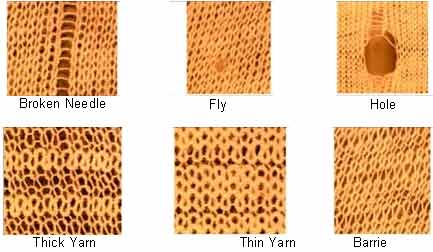
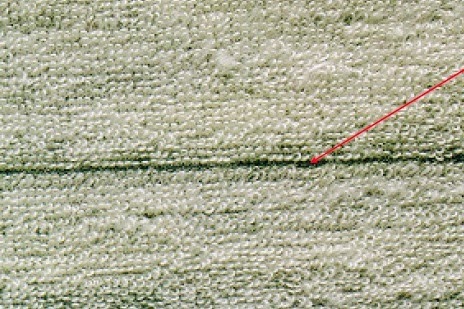
MISSING YARN
DEFECTS IN LENGTH WISE DIRECTION
Dragging end: One or several wales in a warp-knitted fabric in which the laps appear shorter than those in the adjacent normal wales
Cause: This defect is caused by excessive tension in one or more warp yarns.
Remedy: Ensure correct yarn tension on all the feeders and ensure that the Yarn detectors on all the feeders are working properly.
Fish eye pinhole: Small apertures occurring occasionally in a wale.
Cause: This defect is caused by a malfunctioning needle forming random tuck stitches.
Remedy: Ensure uniform yarn tension on all the feeders with a Tension Meter and Rate of yarn feed should be strictly regulated as per the required Stitch Length.
Needle line: A wale that is different in configuration from the adjacent normal wales.
Cause: This defect is caused by a misaligned or.broken needle which forms distorted stitches.
Remedy: Keep recommended gap between the Yarn feeder and Needle and periodically change the needle.
Spirality or wale Spirality: A distortion in a weft-knitted fabric in which the wales are clearly not at right angles to the courses.
Cause: This defect is caused by twist-lively yarn (due to insufficient setting)
Remedy: Use the Hosiery yarns of the recommended TPM level for Knitting and Ensure uniform rate of feed of the dyed fabric on both the edges while feeding the fabric to the Calender, Compactor or Stenter machines.
DEFECTS DUE TO, OR APPARENT AFTER, DYEING, PRINTING OR FINISHING
Barriness: Bands with clearly defined edges that run full-width across a fabric, or spirally in a tubular fabric, and that differ in colour, yarn characteristics or texture from the normal fabric.
Causes: This defect is caused by differential dyeing effects in the areas where yarn characteristics or fabric texture vary from the normal.
Remedy: Ensure uniform Yarn Tension on all the feeders and the average Count variation in the lot should not be more than + 0.3
Dye mark, dye spot, dye stain: In a piecedyed fabric, a discrete area of different colour.
Causes: This defect is often caused by contamination with concentrated dyestuff or dyeing assistants.
Remedy: Scour the grey fabric thoroughly to remove all the impurities from the fabric before dyeing and use appropriate leveling agents to prevent patchy dyeing.
Halo: An area of light colour surrounding a localized thick portion of the fabric after dyeing.
Causes: This defect is often caused by migration of dye during drying or by less dye reaching the area around the thickening (e.g. knot, slub, gout) during pad dyeing.
Remedy: Use the correct dyeing recipe i.e. the appropriate leveling, fixing agents & the correct combination of dyes.
Pilling: Small accumulations of fibre on the sutface of a fabric.
Causes: This defect is usually caused by abrasion during prolonged finishing processes.
Remedy: Avoid using the Tumble Dryer and control shrinkage by maximum fabric relaxation & over feed in the processing.
Water spot: an unwanted pale area in a piece-dyed fabric.
Causes: This defect is caused by contamination with water prior to tinting or dyeing on a pad mangle, which results in a reduction of uptake of dye liquor.
Remedy: Use the Padding mangle only for the application of the softener and use a hydro extractor (Centrifuge) for the extraction to avoid the squeezer roll marks.
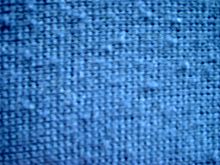
PILLING
GENERAL DEFECTS
Bad odour: A disagreeable smell that is not usually associated with the fabric.
Causes: This defect is often caused by the breakdown of finishing resins, fermented starch, mildew, or the presence of other contaminants.
Remedy: Ensure that the finished material is treated properly
Cockling: An irregular three-dimensional effect in a fabric which prevents it from lying flat.
Causes: This defect is caused by stitch distortion, uneven yarn relaxation or, Shrinkage.
Remedy: Cockling can be corrected nearly 100% of the time with a proper pressing.
Dropped stitch: A wale, within one course, in which the yarn has not been formed into a stitch.
Causes: This defect is caused by a needle failing to take the yarn, or by the yarn casting off from the knitting elements prematurely.
Remedy: The yarn being used should have no imperfections like; Slubs, Neps & big knots and the gap between the Cylinder & the Dial should be correctly adjusted as per the knitted loop size.
Hole: A breakdown in the fabric where one or more adjacent loops are severed.
Causes: This defect can be due to very many causes, amongst which are: careless handling of the fabric, defective machine elements, chemical damage, insect darnage or darnage during finishing such as lack of control during singeing, shearing, etc.
Remedy: Use of flat knots and Yarn Regularity Control
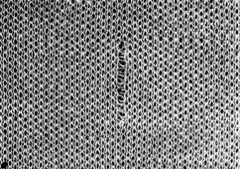
DROPPED STITCH
